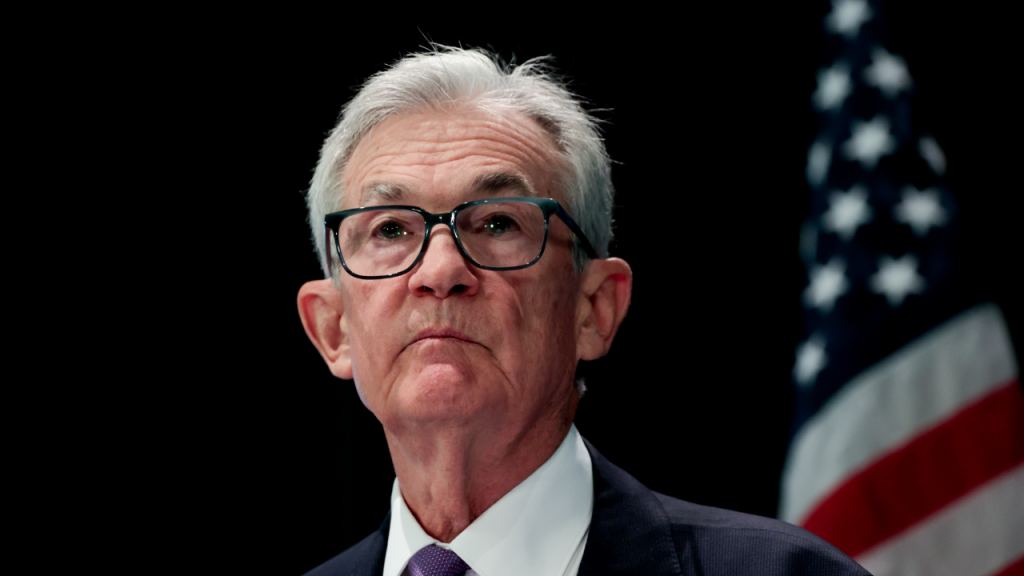The Federal Reserve is widely expected to cut interest rates again at its October meeting, bringing its key borrowing rate down to a level last seen in late 2022. Don’t count on it to cure all of your financial woes.
Like a line of falling dominos, lower rates from the Fed set off a chain reaction across the economy. They bring down the cost of financing big-ticket purchases — like home remodels or cars — as well as the returns that you earn when you keep cash in savings accounts or certificates of deposit (CD).
Over the last year, however, most of the rates that consumers pay haven’t fallen to the same degree as the Fed’s own benchmark, interest rates tracked by Bankrate show. Many financing costs, meanwhile, are also still sitting near decade highs.
Banks are notorious for letting borrowing rates take the elevator up and the stairs down.
— Stephen Kates, CFP, Bankrate financial analyst
Lower rates are also arriving alongside some warning signs for the economy. Hiring has flatlined, and unemployment is rising. All the while, inflation is stubborn, as businesses begin passing along higher costs from tariffs. It’s raising the risk that a weaker economy could be the price consumers must accept for lower interest rates.
Wondering what the Fed’s latest rate cut means for your money? Here’s how borrowing costs, savings yields and financial markets have responded to the Fed’s rate cuts so far — and where they could go from here.
Borrowers
When the Fed cuts interest rates, borrowing costs grow cheaper — at least in theory. In practice, small rate cuts like the one the Fed is expected to announce today are often so small that they go unnoticed.
Take credit card rates, for example. Those rates are usually pegged to the prime rate, which moves in lockstep with the Fed’s benchmark rate. Cardholders typically see their annual percentage rates (APRs) adjust within a billing cycle or two. And, in fact, the average credit card rate has fallen to 20.01 percent from 20.51 percent a year ago, according to Bankrate.
The savings, however, are barely noticeable. Assuming credit card rates fall another quarter of a percentage point, you’ll save just $1.35 a month in interest if you’re making the minimum payment on a $6,473 balance (the national average, according to TransUnion). Over time, that adds up to just about $126 total in interest savings.
Shopping around, comparing offers from multiple lenders and improving your credit score can help you earn the most competitive rate on the market. Concentrate on paying down debt, making your payments on time and utilizing no more than 30 percent of your available credit.
Consumers shouldn’t expect rate cuts to bail them out of credit card debt, Kates says.
If you have credit card debt, consider using a balance transfer card with a 0 percent introductory APR or working with a nonprofit credit counselor, depending on how much you owe.
Borrowing costs on home equity loans, home equity lines of credit (HELOCs) and auto loans have also eased as the Fed has lowered rates, but they remain historically high. If you have a fixed-rate loan, your interest rate won’t change when the Fed cuts rates.
Your monthly payments also depend on the length of your loan and how much you’re financing — factors that are impacting drivers, in particular.
The average rate on a new car loan is about 7 percent, down from 7.62 percent in September 2024, according to Bankrate data. Meanwhile, the average used car loan rate has fallen from 8.52 percent to 7.49 percent over the same period.
If you financed $42,000 over five years (the average loan amount, according to Experian’s latest data), you’d still pay more than $800 a month and save only about $5 if you were able to lock in a rate that’s a quarter of a percentage point lower.
The average new car recently topped a record $50,000, according to Kelley Blue Book.
“My advice for future borrowers who aren’t seeing the rates they want yet is simple: Get your finances in order now, so you’re ready to act when the opportunity arises,” Kates says. “Improving your credit score and strengthening your loan eligibility are firmly within your control and among the most effective ways to lower your borrowing rate. The difference between the rates offered to someone with a 600 credit score versus a 700 credit score can be substantial.”
Savers
Rate cuts may bring borrowers some relief, but they’re generally bad news for savers. After a rate cut, banks start earning less on the cash that they keep in reserves at the Fed — and in turn, they start paying their customers less, too.
To be sure, the pullback has been modest so far. The average savings rate has slipped only 5 basis points since the Fed began cutting rates in September 2024, falling to 0.48 percent from 0.53 percent as of Oct. 22, according to interest rate data tracked by Bankrate. Competition and demand for depositors influence bank yields.
Yields at online banks, though — where savers can often find the best returns — have fallen sharply. Back in July 2024, the top high-yield savings account on the market paid a 5.55 percent annual percentage yield (APY) back, according to Bankrate data. As of Oct. 28, the top yield on the market is more than a percentage point lower, at 4.26 percent.
CDs are following a similar trend. Shorter-term CDs have dropped the most, with the top 1-year CD currently paying 4.05 percent a year in interest (down from 5.36 percent in July). Longer-term CDs — such as the 2-year (4 percent, down from 4.53 percent) and 5-year (3.91 percent, down from 4.25 percent) — have also slipped, though not as much. Those yields are tied to longer-run interest rate expectations.
Yields will often fall in mere anticipation of a Fed rate cut. That’s exactly what happened in the days leading up to this month’s Fed meeting, when yields on savings accounts and CDs all edged lower. If the Fed hints at more rate cuts ahead, yields could keep drifting down.
If you’re saving for emergencies, stick with an account that’s liquid and easy to access, like a high-yield savings account. Once you’ve built up at least six months of expenses, think about locking in a CD to secure today’s still-elevated yields for longer.
Still, there’s a silver lining for savers: Yields remain the highest they’ve been in over a decade, and they’re beating inflation. Back in 2019, the best online savings account paid just 2.1 percent.
Online banks can usually offer depositors higher returns because they don’t have the same overhead costs as brick-and-mortar banks. Bankrate’s top picks for the best online banks are also insured by the Federal Deposit Insurance Corp. (FDIC), meaning they’re a risk-free investment.
Homeowners and homebuyers
After spending most of the year hovering just below 7 percent, mortgage rates have finally retreated. The average rate on a 30-year fixed mortgage fell to 6.26 percent during the week ending Oct. 22, the lowest level in a year, according to Bankrate data. That’s down from 6.35 percent the prior week and well below the 7.19 percent high reached in mid-January.
It’s welcome news for would-be homeowners who’ve been priced out by high borrowing costs. The drop in mortgage rates this year translates to major savings, translating to nearly $300 in monthly savings on a $500,000 loan, Bankrate calculations show.
Still, mortgage rates don’t move directly with the Fed. They tend to follow the 10-year Treasury yield, which often rises and falls based on expectations for inflation, government spending and economic growth. Yields have been volatile this fall as investors weigh concerns of a slowing job market along with fears of higher inflation from tariffs and rising federal debt.
Mortgage rates might not fall much more from here, according to Odeta Kushi, deputy chief economist at First American Financial Corporation. She projects that they’ll hold between 6.3 and 6.5 percent through 2026, rarely dipping below 6 percent.
“Rates in the 6s are looking more like the new normal,” she says. “It’s possible we could see a 5-handle again, but we do need to anchor our expectations beyond a 3-to-4 handle to maybe something in the 5-6 range.”
To get the best mortgage rate, shop around and compare quotes from at least three lenders. On the personal finance side, work to boost your credit score, pay down debt and save for a larger down payment.
High rates, of course, are only one piece of the affordability puzzle. Home prices remain historically elevated, even if growth has slowed. The median price of an existing home sold in September 2025 was $415,200, according to the National Association of Realtors.
That said, incomes are rising faster than home prices, Kushi says, and homes are staying on the market longer, adding to signs that affordability is starting to improve. Still, relief will take time, she adds. In some places where supply is still constrained, lower mortgage rates might even cause housing prices to pop again. Her top advice is try not to time the market.
“We can’t look to lower mortgage rates to save the housing market,” she says. “We’re already starting to see affordability improve, which on the margin should help some potential buyers, but affordability is still significantly below where it was pre-pandemic. That is going to take some time to heal.”
Investors
The stock market has been defying gravity, and lately, it doesn’t look like anything can bring it down. Fueled by AI enthusiasm, solid economic data and a more dovish Fed, the S&P 500 has jumped nearly 18 percent so far this year, rebounding sharply from its post–“Liberation Day” slump in April.
That optimism, though, has some on Wall Street worrying about whether a bubble might be forming. Even Fed Chair Jerome Powell seemed to acknowledge investors may be getting ahead of themselves.
“By many measures, for example, equity prices are fairly highly valued,” Powell said in public remarks from September. “We do look at overall financial conditions, and we ask ourselves whether our policies are affecting financial conditions in a way that is what we’re trying to achieve.”
There is some froth out there, according to Ryan Detrick, CMT, chief market strategist at Carson Group. But “just because something is quote, unquote ‘overvalued,’ that doesn’t mean it’s a bad value,” he says. To help calm clients nervous about a possible stock market bubble, he often finds himself repeating one mantra: “When in doubt, diversify it out.”
“Every year is going to have scary headlines, and every year is going to have volatility,” he says. “If you go into the year knowing there’s going to be scary headlines and volatility, you probably don’t need to make a rash decision in the midst of it. It’s really important for longer term investors to remember that volatility is the price we pay to invest.”
This is a developing story. Check back throughout the day for more updates and analysis as Bankrate reacts to the Fed’s October rate decision.
Why we ask for feedback
Your feedback helps us improve our content and services. It takes less than a minute to
complete.
Your responses are anonymous and will only be used for improving our website.
Help us improve our content
Read the full article here












